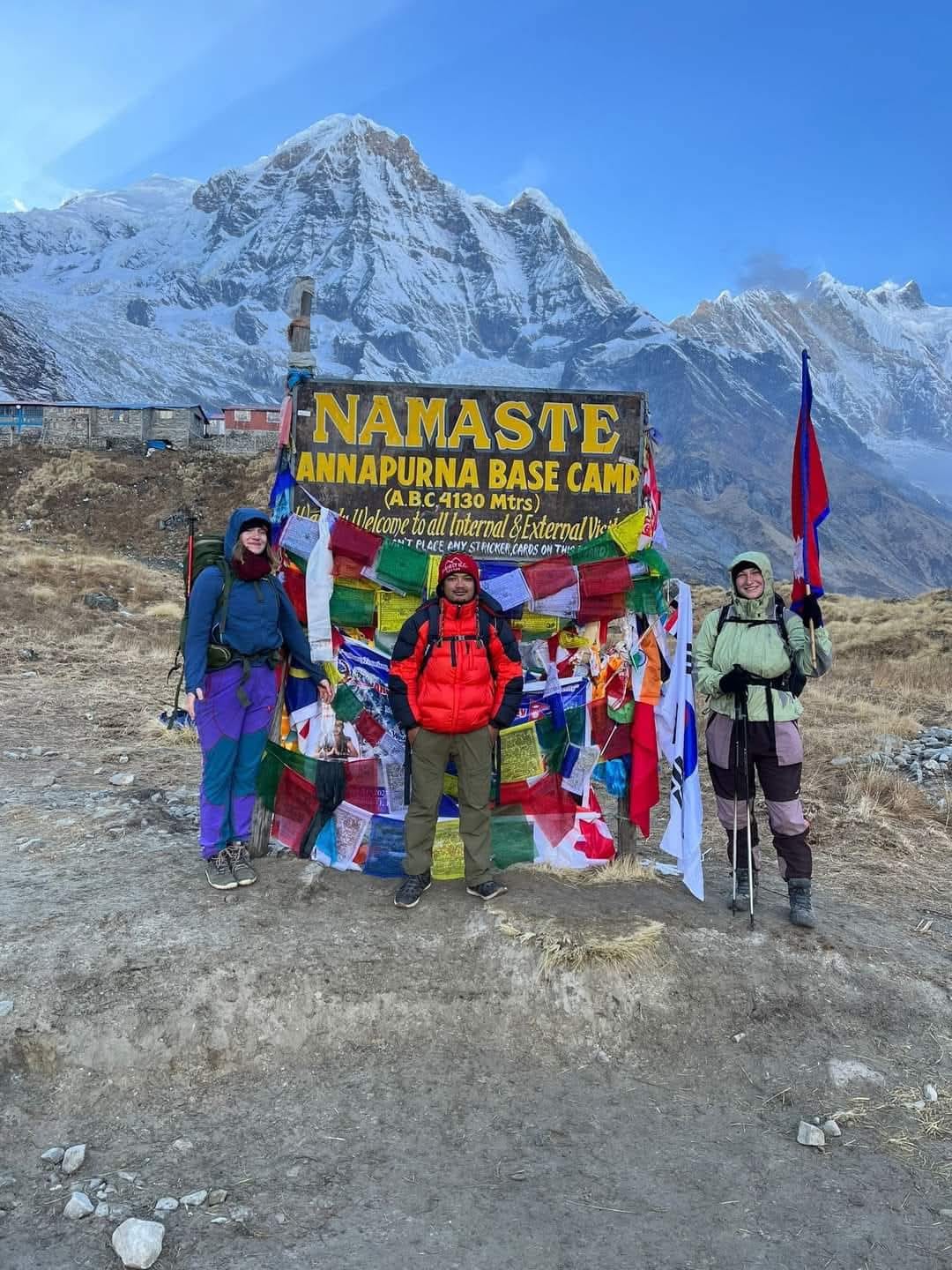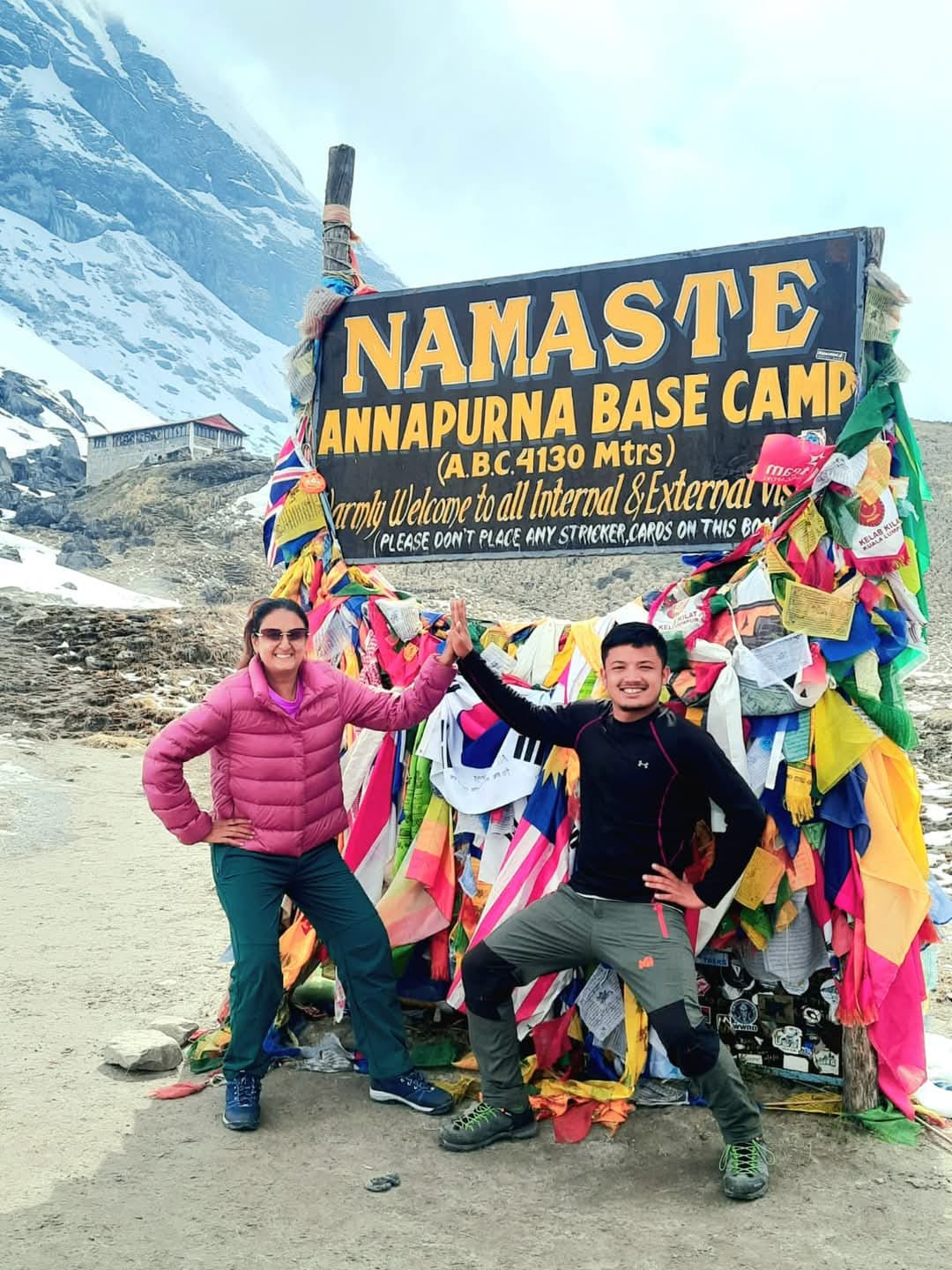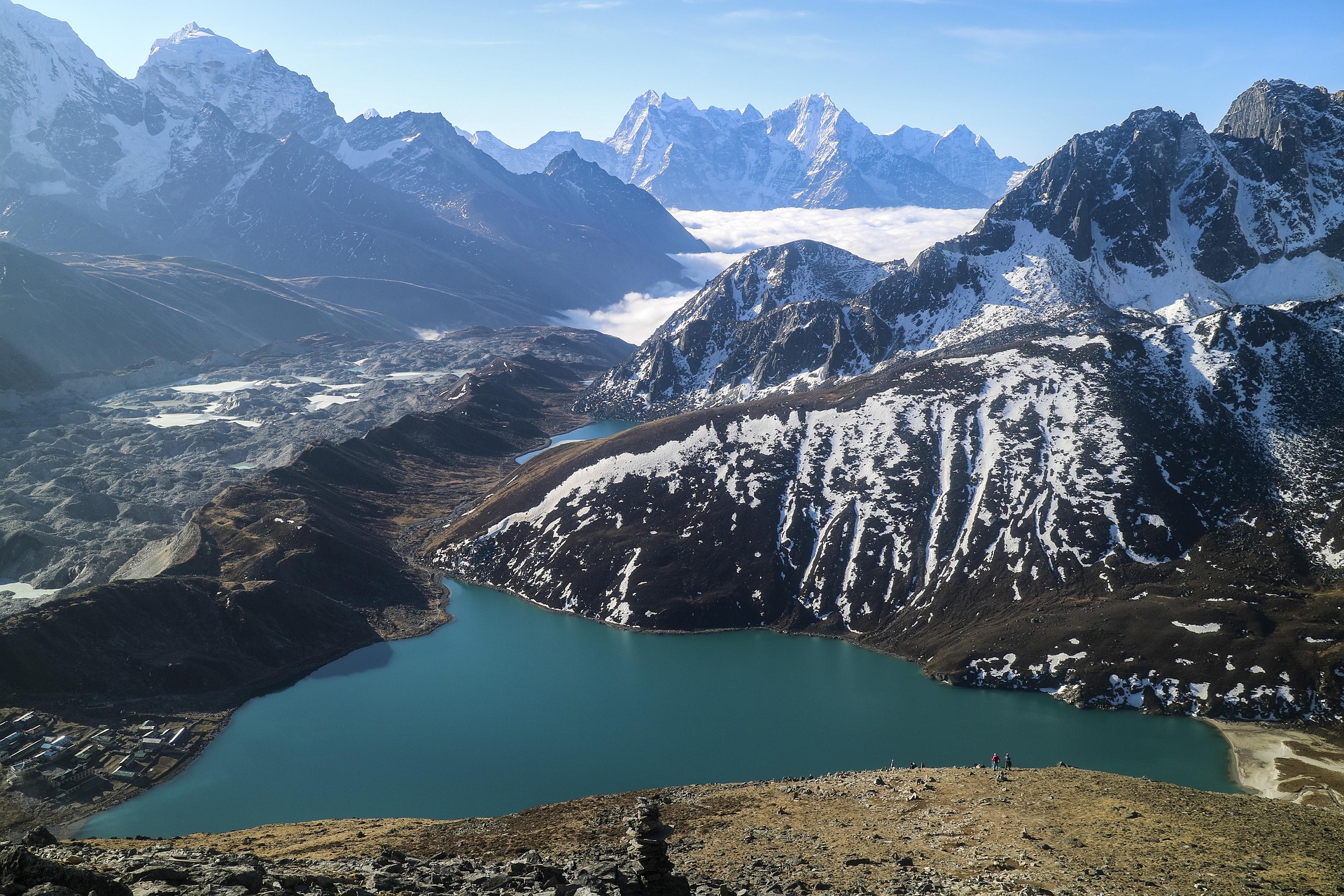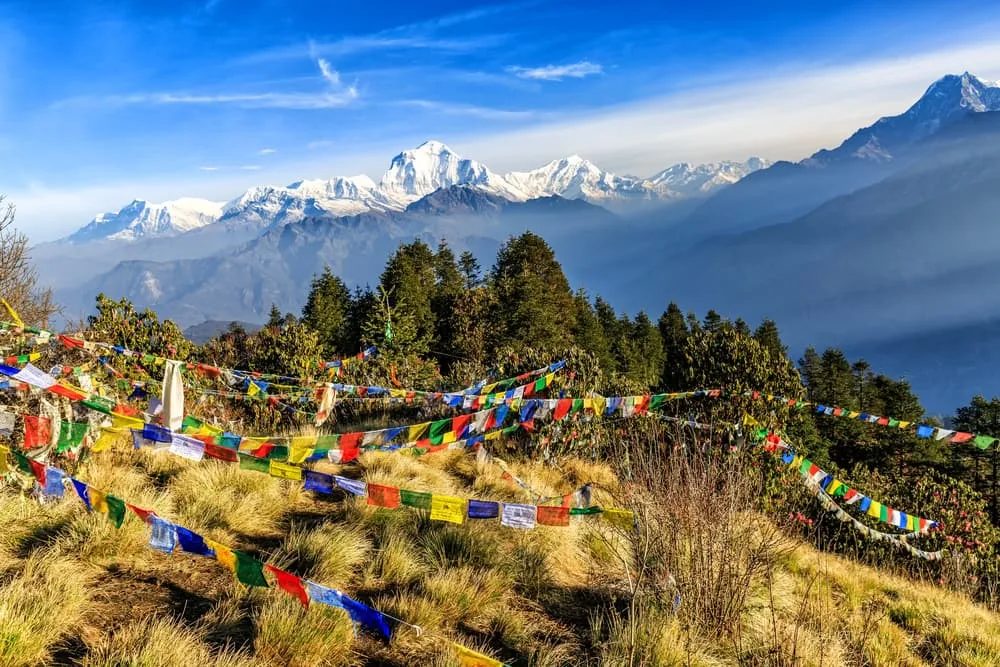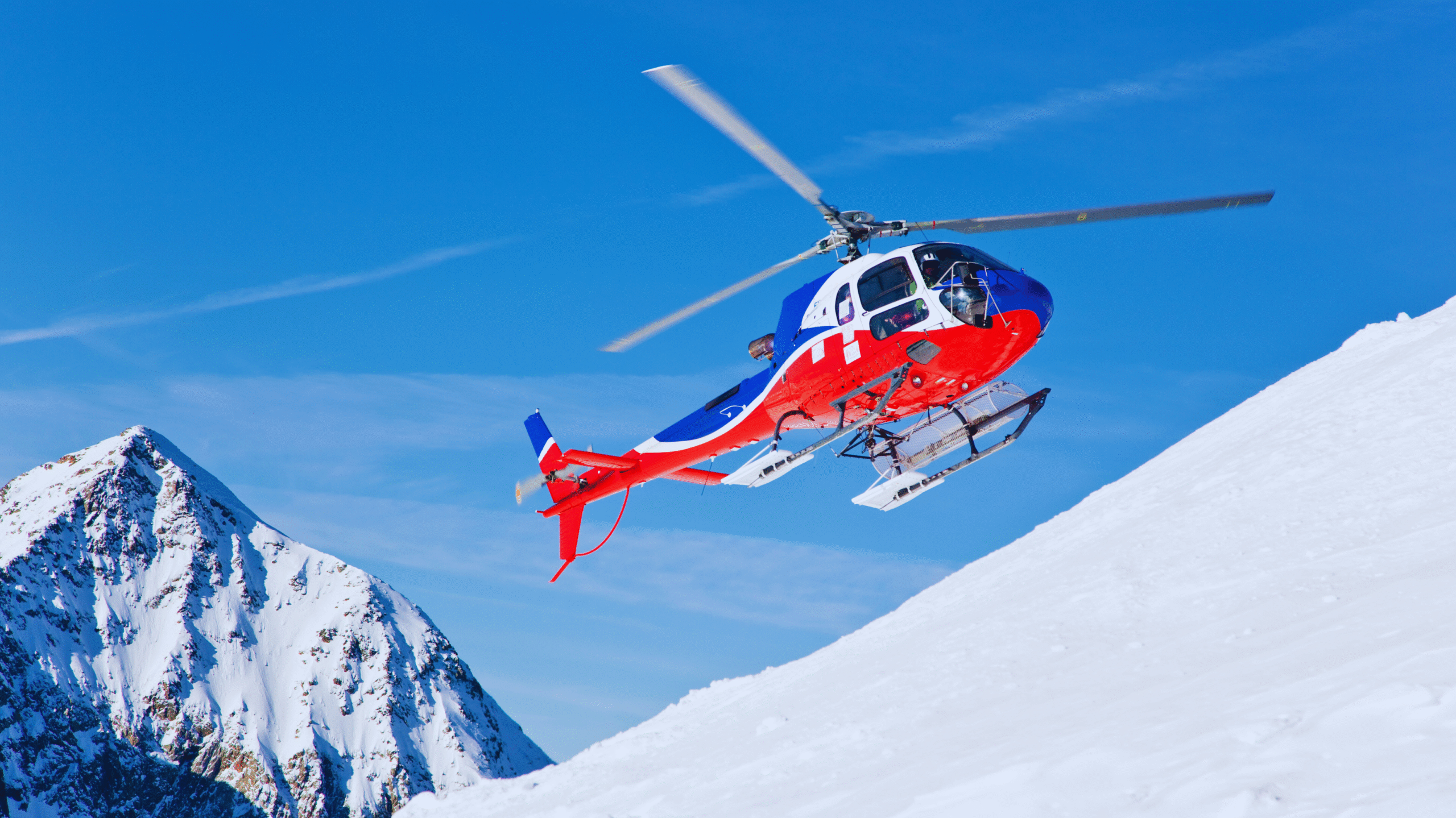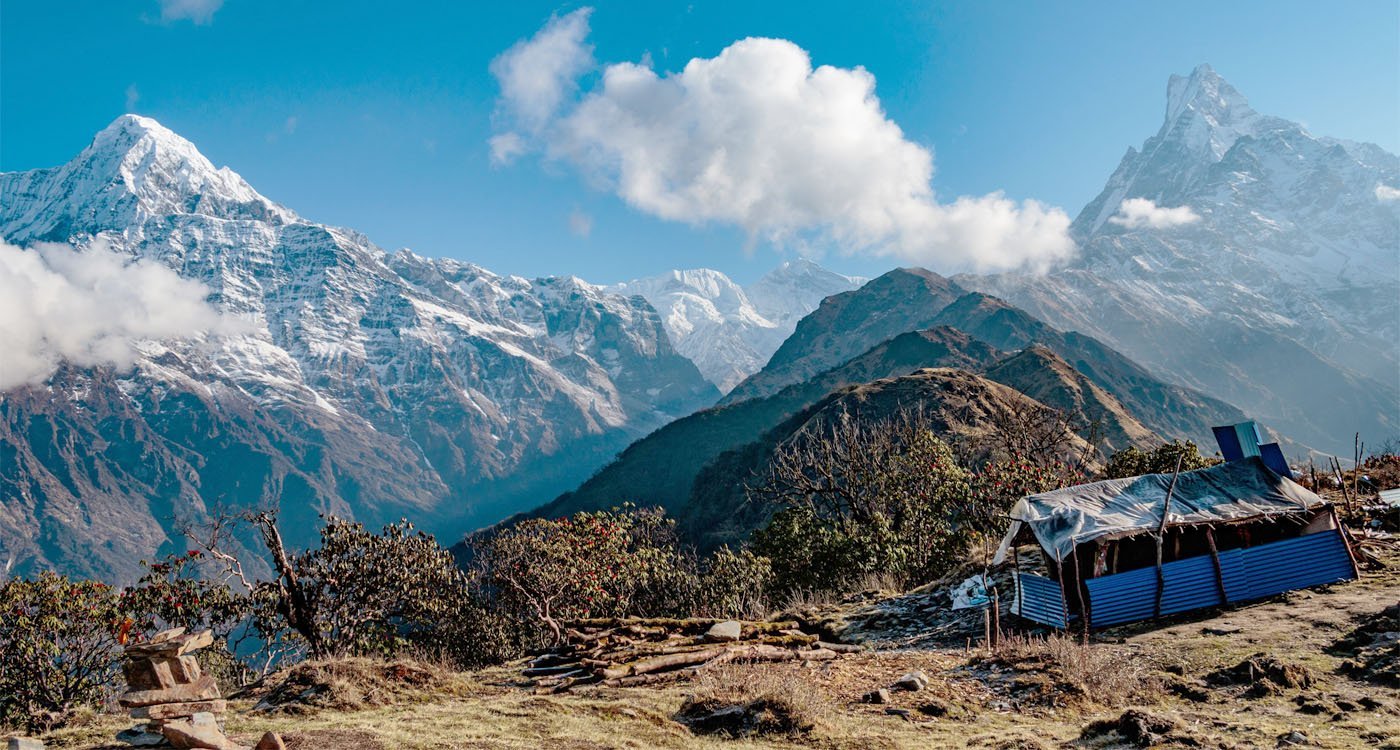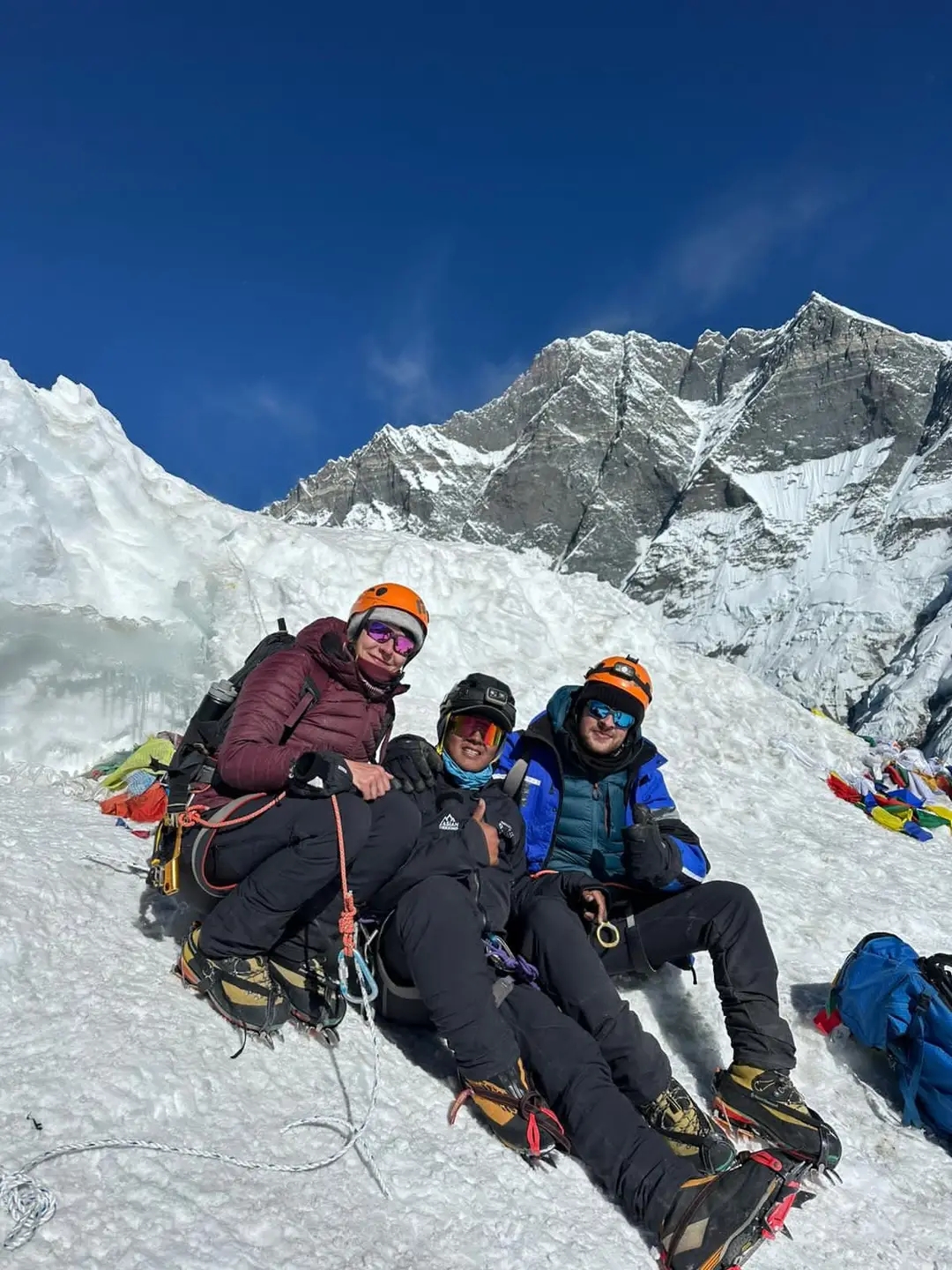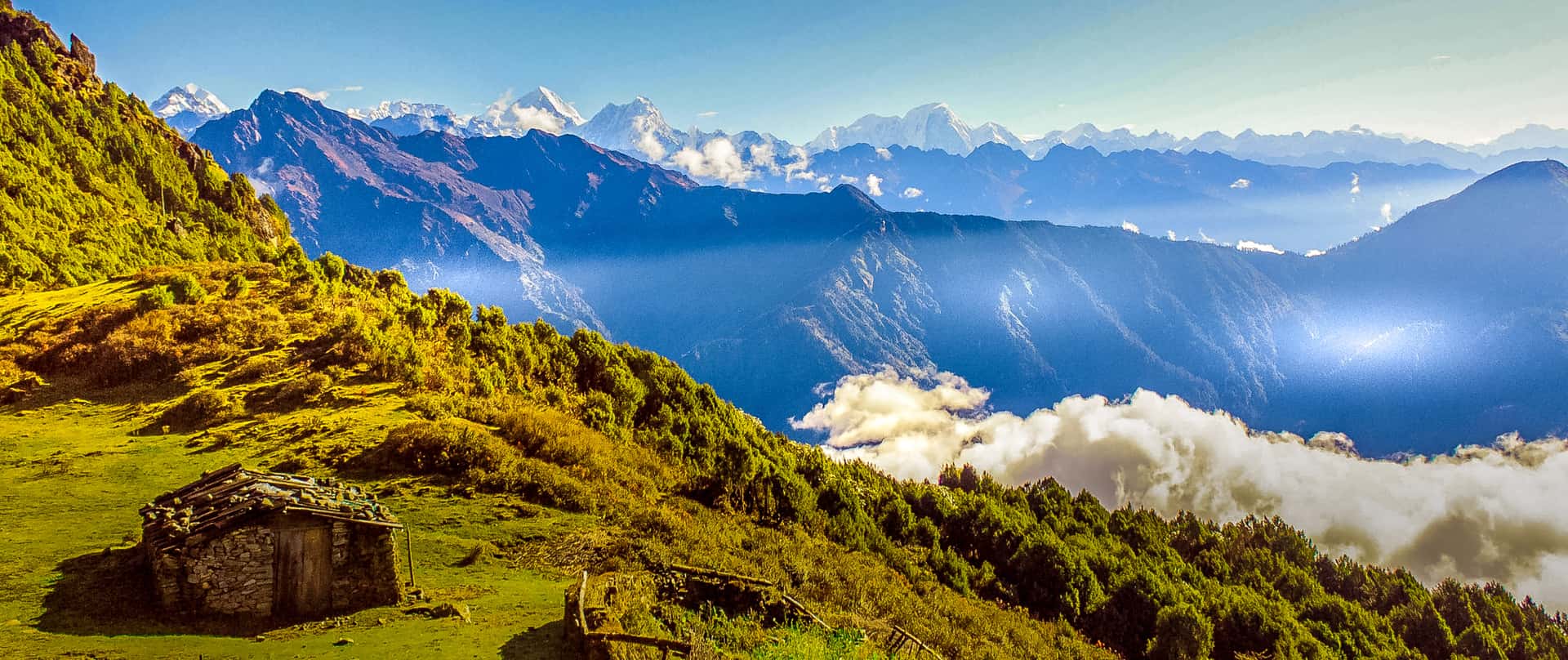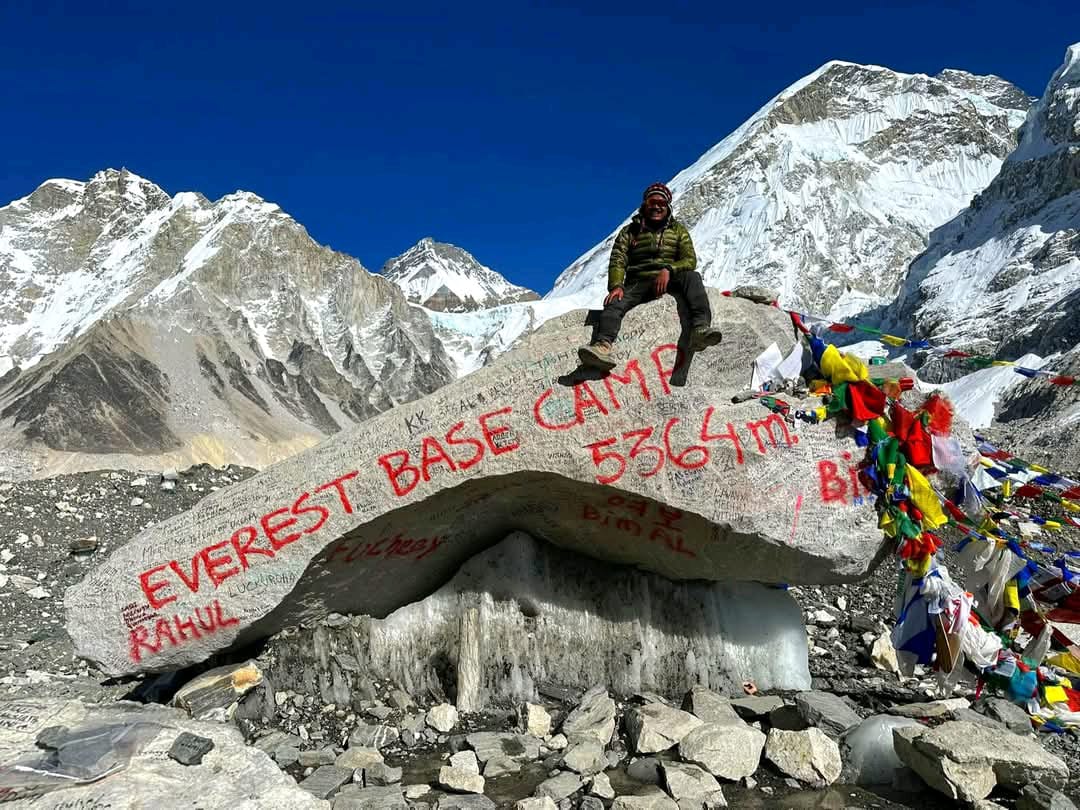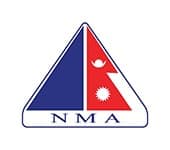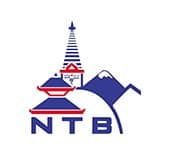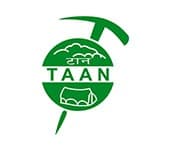7 Day Annapurna Base Camp Trek Itinerary (Pokhara to Pokhara)
Destination
Annapurna Base CampDuration
7Accomodation
Guest House and HotelTrek Style
Tea HouseMax Elevation
4130Trek difficulty
Moderate TrekBest months
Autumn & SpringTrip starts/Ends
PokharaOverview
The 7- day Annapurna Base Camp Trekking is the perfect option for those who want to experience the iconic beauty of the Annapurna region in a shorter time frame. This compact yet immersive journey passes through the enchanting Gurung villages, lush forests and impressive abundance of alpine terrain.
also known as Annapurna Sanctuary Trek, leads to the base of the mighty Annapurna at an altitude of 4130 meters. Along the way, you can meet in the views of summits such as Machapuche (fishtail), hiunchuli and Annapurna.
Spring is probably the perfect time to go on this hike when the forest of Rhododendrons explodes in live tones of red, pink and white, creating a breathtaking contrast to the coarse Himalayan background. Nevertheless, the hike is accessible and rewarding all year round. You will be an impressive lineup of snowy giants including Mount Daulagiri, Annapurna, Manasru, Annapurna II , Annapurna and Annapurna. Annapurna, Annapurna, Annapurna, Witness. South , Nilgiri, Machapu Chair, hiunchuli, Ramuenhimal, and Tukce Peak. From the base camp in Annapurna itself, you can also see panoramas with tarpchuli (5,663 m), singu chuli (6.501 m), and surrounding peaks that form a breathtaking natural amphitheater.
Hiking is also rich in cultural and spiritual experience. Expect to run an old Buddhist choir, wing-flapping prayer flag, meadow bridges and traditional Tibetan villages. Bamboo fields, rhododendron forests and terrace arable lands add more texture to your trip.
Your adventure begins with a picture-like journey from Kathmandu to Pokhara and a picture-like journey up to Nayapul (1,050 m), the gate to the road. From here, you will be hiking along the Modi Kola River and climbing picturesque hills and rice terraces. The most important stop is the traditional village Gandruk, followed by Chhomrong (2,170 m). If you continue your trip to the Himalayas, stay in a cozy guesthouse and enjoy the quiet rhythms of Highland Life. This 7-day hike is more than just a hike.
Trip Highlights
- Scenic drive from Pokhara to Nayapul, passing through charming hillside villages and lush valleys
- Explore the traditional Gurung village of Ghandruk, with up-close views of Annapurna South, Hiunchuli, and Machapuchare
- Walk through diverse landscapes — terraced fields, bamboo forests, rhododendron groves, and alpine meadows
- Visit two iconic base camps: Machapuchare Base Camp (3,700m) and Annapurna Base Camp (4,130m)
- 360° Himalayan views at ABC, surrounded by giants like Annapurna I (8,091m), Annapurna South, and Fishtail Peak
- Witness dramatic sunrises over snow-covered peaks from the heart of the Annapurna Sanctuary
- Relax in the natural hot springs of Jhinu Danda, a perfect way to unwind after days of trekking
- Experience the rich cultural blend of Hindu and Buddhist traditions in the villages along the trail
- Short yet immersive trekking experience, ideal for those with limited time but a strong will for adventure
- Trek support with experienced local guides and cozy mountain teahouse accommodations
Itinerary
Day 1
Duration: 5–6 hours
We started our trips with 1.5 hours of paintings on the way from Pokhara to Nayapul, passing through the lush valleys and traditional villages. From Nayapul, we registered at the TIMS and ACAP Control Station in Birethanti and followed the road next to Modi Khola. The trail is gradually rising through the stairs and small colonies like Kim Chi and Chan before coming to the magnificent village of Ghandruk. Here, we have the majestic views of Annapurna South (7,219 m), Hiunchuli (6,441 m) and Machapuchare (fishtail, 6,993 m).
Day 2
Duration: 5–6 hours
After breakfast, we followed a road that was built well to Kimrong Khola, then climbed strongly through the forests to Taulung village. The road continued to increase and ended as Chhomrong approached, the last large colonization on the way to ABC. From there, you will have a great close look of Annapurna South and Machapuchare. Chhomrong is a living village with a blend of local platforms and charm.
Day 3
Duration: 6–7 hours
The road fell to Chhomrong Khola then climbed strongly through the lush forests to Sinuwa. By continuing through dense bamboo and vegetation bombing, we passed bamboo and Dovan before arriving in the Himalaya. This peaceful judgment is nestled in the wooden canyon of the Modi River Valley. The vegetation becomes thinner and the air cooler, while we go up.
Day 4
Duration: 6–7 hours
Today is the most rewarding day of the hike. We steadily rise through Deurali and reach the Machapuchare Base Camp bearing surrounded by the peaks of high containers. After a break here, we continue our trip to Annapurna Base Camp. As you approach the base bearings of Annapurna, you are surrounded by a snow-covered 360 views. This is a great altitude and unforgettable goal.
Day 5
Duration: 6–7 hours
After seeing the breathtaking sunrise through the Annapurna mountains, we begin our descent when we come. The route passes through the base camp and deurali, Through the familiar forests and streams. Surrounded by a quiet forest environment and sounds of running through the river, we stop by bamboo for the night.
Day 6
Duration: 5–6 hours
We return the steps to Sinuwa and climb to Chhomrong. From here, a sudden descent into Jinudanda leads us. There you can only relax in the natural hot springs below the village. It’s the perfect place to soothe your muscles after a few days of trekking.
Day 7
Trek Duration: 2–3 hours | Drive Duration: 2.5–3 hours
Our last day went downhill through agricultural land in the terrace and peaceful villages in Siwai, where our car would wait. After the trip, we took advantage of a picturesque journey in Pokhara, ending the adventure of the farm base Annapurna base short but amazing.
Route Map

Elevation Chart

What's Included
- Three meals a day (Breakfast, Lunch, and Dinner/ the main course)
- One nights’ standard accommodation in a 2-star hotel in Pokhara in a twin-sharing basis including breakfasts.
- A professional, licensed, English-speaking mountain guide.
- Well-experienced and equipped trekking porter
- All Food, Accommodation, Insurance, and transportation for porter and guide.
- Annapurna conservation area permit TIMS card (Trekking Information Management System)
- Sleeping bag, down jacket, duffel bag
- Guesthouse accommodation during the trek.
- Assistant guide group size of more than 5 people in a group.
- Pokhara-Nayapul- Sinuwa – Pokhara by Private Car or Jeep.
- Emergency rescue operation assistance in arranging in case of complex health condition (funded by travel insurance)
- First-aid kit, plus an oximeter to monitor pulse, heart rate, and oxygen levels at high altitudes.
- All government, Local taxes/ vat and official Expenses
What's Excluded
- Meals whilst you are in Pokhara – lunch, and dinner.
- Personal travel and medical insurance.
- International airfare.
- Your personal expenses.
- All the alcoholic and nonalcoholic, soup, tea, coffee, hot chocolate, cocoa, mineral water, extra food, cold and hot drinks on trek
- All desserts & sweet things like chocolate, cake, pie, pudding.
- Hot shower, battery charging & drinking water at the tea houses.
- Tips for the guide, porter, and driver.
Gallery
Equipment
Equipment List for Annapurna Base Camp Trek – 7 Days
Clothing
- Base Layers (Inner Wear)
- 2–3 moisture-wicking T-shirts (synthetic or merino wool)
- 1–2 thermal tops and bottoms
- Insulating Layers
- 1 fleece jacket or pullover
- 1 down jacket (lightweight and warm)
- Outer Layers (Shell)
- Waterproof and windproof jacket
- Waterproof trekking pants or rain pants
- Bottoms
- 2–3 pairs of trekking pants
- 1 pair of shorts
- Undergarments
- 3–4 pairs of moisture-wicking underwear
- 3–4 pairs of trekking socks
- 1 pair of thermal socks
Footwear
- Waterproof hiking boots (well broken-in)
- Lightweight sandals or camp shoes
- Gaiters (optional)
Headwear & Handwear
- Warm beanie or wool hat
- Sun hat or cap with neck protection
- Buff or neck gaiter
- UV-protection sunglasses
- Lightweight liner gloves
- Insulated gloves or mittens
Backpacks & Bags
- 35–45L daypack (with rain cover)
- 60L duffel bag for porter
- Waterproof stuff sacks or dry bags
- Small lock
Sleeping
- Sleeping bag (-10°C to -15°C rating)
- Sleeping bag liner (optional)
- Earplugs
Personal Hygiene & Toiletries
- Toothbrush & toothpaste
- Biodegradable soap
- Quick-dry towel
- Wet wipes
- Toilet paper
- Hand sanitizer
- Lip balm with SPF
- Sunscreen (SPF 30+)
- Moisturizer
- Razor (optional)
- Nail clipper
Health & First Aid
- Personal first aid kit
- Water purification tablets or filter
- Altitude medication (consult doctor)
- Pain relievers
- Prescribed medicines
- Rehydration salts or electrolytes
Accessories & Tools
- Headlamp with extra batteries
- Trekking poles (adjustable)
- Reusable water bottles (2L total)
- Pocket knife or multi-tool (optional)
- Power bank (10,000 mAh+)
- Charging cables
- Adapter (Type C, D & M)
Optional but Useful
- Camera or GoPro
- Journal and pen
- Books or e-reader
- Travel games/cards
- Snacks (trail mix, protein bars, chocolate)
Documents & Money
- Valid passport (copy + originals)
- Travel insurance copy
- Extra passport-sized photos (2–3)
Pro Tips
- Keep daypack under 7–8kg and duffel under 15–20kg
- Layer for variable temperatures
- Pack essentials only – go lightweight
Essential Info
Essential Information: Annapurna Base Camp Trek – 7 Days
Trip Overview
Trip Name: Annapurna Base Camp Trek (Short Version)
Duration: 7 Days
Starting/Ending Point: Pokhara
Max Elevation: 4,130m (Annapurna Base Camp)
Trek Difficulty: Moderate
Accommodation: Tea houses/lodges
Meals: Full board (breakfast, lunch, dinner) during trek
Group Size: 1–15 pax (private & group join available)
Best Seasons for ABC Trek
The best time to do the Annapurna Base Camp Trek is during the spring (March to May) and autumn (September to November) seasons. These
Periods offer:
- Clear skies and spectacular mountain views
- Blooming rhododendron forests in spring
- Pleasant daytime temperatures
- Lower chance of rain or snowfall
- Winter treks (Dec–Feb) are also possible with proper gear, but temperatures can drop well below freezing at higher altitudes.
Summer/monsoon (June–August) is the least recommended due to rain, leeches, and cloud-covered views.
Trek Difficulty & Fitness Level
The ABC Trek is rated as moderate. It does not involve technical climbing, but you will be hiking for 5–7 hours daily over varied terrain including stone steps, forest trails, and high-altitude alpine zones.
A basic level of fitness is required. Prior hiking experience is helpful but not mandatory. The itinerary includes proper acclimatization. Drink plenty of water and communicate any symptoms to your guide.
Accommodation & Meals
You’ll stay in locally-run tea houses or mountain lodges, which offer basic facilities like twin-sharing rooms, shared bathrooms, and warm dining areas.
Meals include traditional Nepali dal bhat, as well as noodles, soups, pancakes, and eggs. Veg and non-veg options are available. Bring water purification tablets or filters.
Permits Required You will need the following permits:
1. ACAP (Annapurna Conservation Area Permit)
2. TIMS Card (Trekkers’ Information Management System)
These are usually arranged by your guide. Bring a copy of your passport and two passport-sized photos.
Altitude & Acclimatization
- Highest point: Annapurna Base Camp at 4,130 meters.
- Tips to avoid altitude sickness:
- Stay hydrated (3–4L per day)
- Ascend gradually
- Avoid alcohol and smoking
- Rest if symptoms appear
Luggage & Porter Service Carry a backpack (10–15kg max). Extra luggage can be stored in Pokhara.
Porters can carry up to 20–25kg (shared between two trekkers).
Carry a daypack with essentials like water, snacks, and rain gear.
Travel Insurance
- Travel insurance is mandatory and should cover:
- High-altitude trekking (up to 4,500m)
- Emergency helicopter evacuation
- Trip cancellations and medical expenses
- Bring a printed copy of your insurance policy.
Connectivity & Charging
- Wi-Fi available in some lodges (often paid)
- Limited mobile coverage (NTC/Ncell)
- Bring a power bank and spare batteries for your devices
Packing Tips
- Pack light and smart
- Layer clothing for flexibility
- Well-broken-in trekking boots are essential
- Don’t forget sunscreen, sunglasses, and a hat




